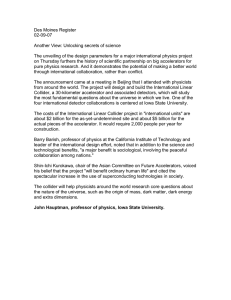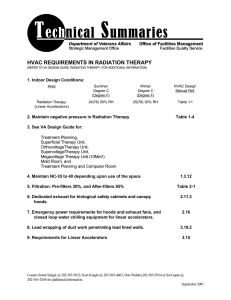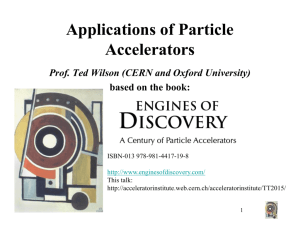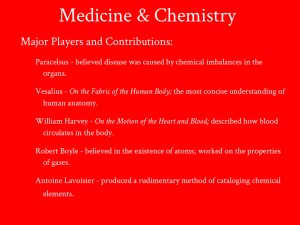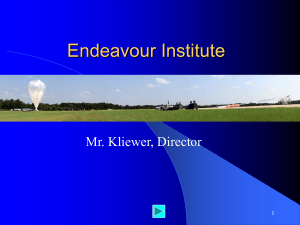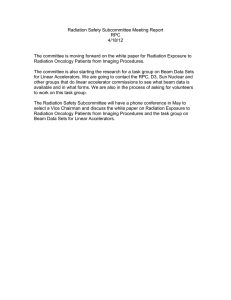Popular Talk: AntiMatter
advertisement
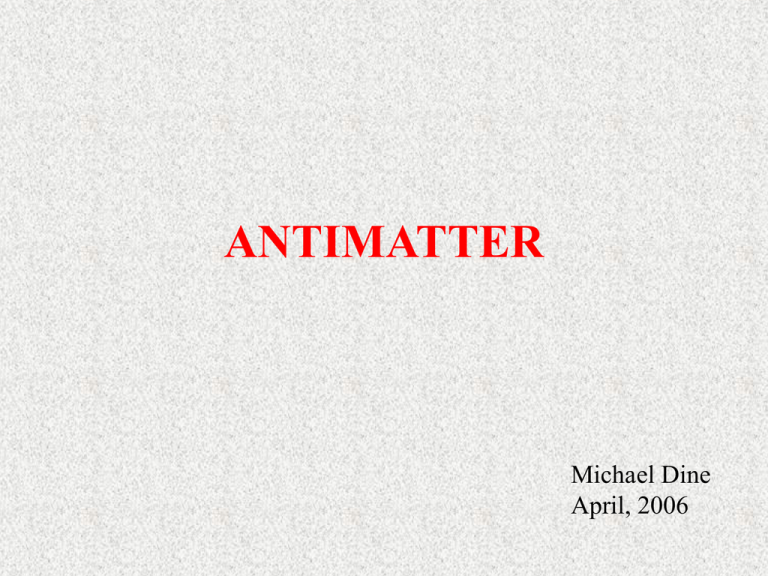
ANTIMATTER Michael Dine April, 2006 Prediction of Antimatter •1931 Dirac, English theoretical physicist, realizes relativity + quantum mechanics means antiparticle of electron exists. Has same mass as the electron, but the opposite charge. Called the ``positron”. matter-antimatter annihilation p- + p + g+g neutrino decoupling e- + e+ n+n Discovery of Antimatter •1933 Positron discovered in cosmic rays (radiation from space) by Anderson. Accelerators Accelerators: Like electron microscopes. Quantum mechanics: more energy greater resolving power. Since the 1940’s, take particles like electrons and protons to very high energy. If enough energy, by E=mc2, can produce other particles. Lots of particles discovered. The largest accelerators today: •SLAC (e-, e+) •Fermilab (p-,p+) •CERN LHC (under construction p- p+) Aerial View of SLAC Fermilab – outside Chicago. E= 1000 mp c2 E= 10,000 mp c2 Over 60 years, accelerators have discovered many types of particles and antiparticles. One of the first interesting discoveries: the antiproton. (Berkeley, 1953) OWEN CHAMBERLAIN (father of Pia Chamberlain; passed away earlier this year; memorial in Berkeley today) Nobel Laureate in Physics, 1959 Guggenheim Fellowship, 1957 Professor Emeritus of Physics UNIVERSITY OF CALIFORNIA, Berkeley, Fellow of the American Physical Society, National Academy of Sciences Particle physicists have discovered the laws of nature which operate on scales of atoms, atomic nuclei, and much smaller (1000 times smaller than the nucleus). Highlights: • Quarks (discovered at SLAC, 1969) • Gluons – hold quarks together in protons and neutrons. Responsible for the nuclear forces. • Neutrinos – three kinds. Interact extremely weakly through matter (pass through huge amounts without stopping). • Heavier particles like electrons (“leptons”-muon,tau) • W’s, Z’s: ``Cosmic Alchemists” PDG Wall Chart 3 Nobel Prizes in Physics 1976 - Burton Richter “Charm” or the 4th Quark 1995 - Martin Perl Tau Lepton 1990 - Richard Taylor Quarks Structure Inside Protons and Neutrons THE BIG BANG • We know that the universe is expanding today. • It was much smaller – things were much closer together – in the distant past. 15 billion years ago – everything essentially on top of each other. • How do we know: 100,000 years after the big, radiation – the Cosmic Background Radiation. Discovered by accident. Artist’s Rendering of COBE COBE measured the temperature of the universe: More detailed study of the CMBR: From satellites and earth based (balloon) experiments. Most recently the WMAP satellite. Detailed information about the universe: Latest from WMAP (March 2006) COMPOSITION OF THE UNIVERSE If 5% of the Universe is Baryons, What is the Rest? From studies of CMBR, of distant Supernova explosions, and from Hubble and GroundBased observations we know: • 5% Baryons (protons, neutrons) • 35% Dark Matter (zero pressure) • 65% Dark Energy (negative pressure) Sakharov’s Puzzle When the universe was very hot (1012 oK and hotter) there was so much energy that photons colliding produced protons and antiprotons, neutrons and antineutrons. Almost exactly as much matter as antimatter. The tiny bit of excess matter is what we see today as stars, planets, people… Sakharov explained how one could understand this small difference. Crucial is that nature is not exactly symmetric between matter and antimatter. Not many situations where one can study this small difference – one is here at SLAC (BaBar). Need also to understand how this difference is processed in the Big Bang. Inner part of Babar – Silicon Vertex Detector (UCSC) http://www.space.com/scienceast ronomy/antimatter_040831.html http://unisci.com/stories/20011/0 219014.htm http://scipp.ucsc.edu/~dine/ http://www.slac.stanford.edu/BF ROOT/ What comes next? Many questions still to answer. Many speculations on the answers (supersymmetry, string theory). 2007: A new accelerator at CERN (Geneva) Experiments looking for the dark matter Farther into the future: the International Linear Collider http://www4.nationalacademies.org/ne ws.nsf/isbn/0309101948?OpenDocume nt The Large Hadron Collider - LHC CMS ATLAS The Large Hadron Collider: _ proton-proton collider (no p) ⇨2 separate beampipes first collisions in 2007 high energy: s = 14 TeV 40 Mio. collisions per second 4 experiments: ATLAS, CMS, ALICE, LHC-B 10 fb-1 per year Courtesy A. Quadt LHC dipoles LHC quadrupoles The ATLAS & CMS Experiment weight height length magnet (solenoid) 7 000 t 22 m 42 m 2 Tesla weight height length magnet (solenoid) 12 500 t 15 m 22 m 4 Tesla Precise tracking and vertexing silicon pixel and strip detectors & transition radiation det. 2 & 4 T solenoid and toroid magnets (air core or iron core) EM & Had Calorimeters and muon systems Fast DAQ/trigger resolutions: EM: σE/E = 0.5 - 10% / sqrt(E) ~ 1 600 physicists each HAD: σE/E = 50 – 70 % / sqrt(E) Courtesy A. Quadt The ATLAS and CMS Experiment The Stanford Synchrotron Radiation Laboratory • SPEAR is the small storage ring where the charm quark was discovered. • Accelerated electrons give off light including xrays • During HEP runs, this light was used parasitically to study materials. • So many uses for this intense x-ray source were found that now all of SPEAR is devoted to research using synchrotron light. • It is so useful that about 50 dedicated light sources have been built around the world. Protein Crystallography with Structure of RNA Synchrotron Light polymerase II enzyme Measured with X-ray diffraction This enzyme reads the DNA to make RNA Molecular weight of 500,000 Resolution of 2.8 Angstroms The protein shape determines how it works. Setting up to mass produce such measurements on thousands of proteins. Using Synchrotron Light • X-ray spectra used to understand the magnetic layers on a disk drive. • Makes use of the polarization, high brightness, and fine wavelength selection from SSRL • Phys. Rev. Lett. 87, 247201 (December 10, 2001) Spin-offs • Medical accelerators – 1 in 7 of you will owe your life to cancer treatment from a medical accelerator – There are 5000 such accelerators in the US. • Synchrotron radiation – There are about 50 facilities around the world – First was here at SLAC (still upgraded and used) • WWW – Created at CERN in Geneva, our sister lab – SLAC put up the first American web site – First killer app was SLAC’s online HEP publications database. • Polarized helium or xenon for lung imaging
